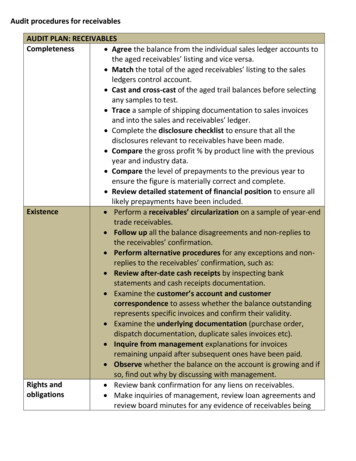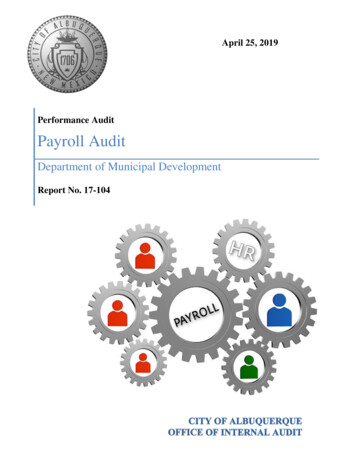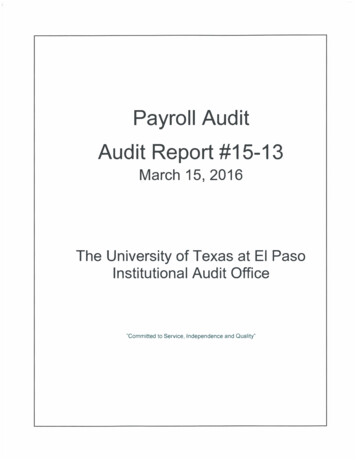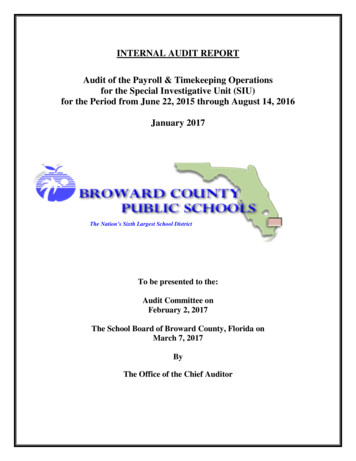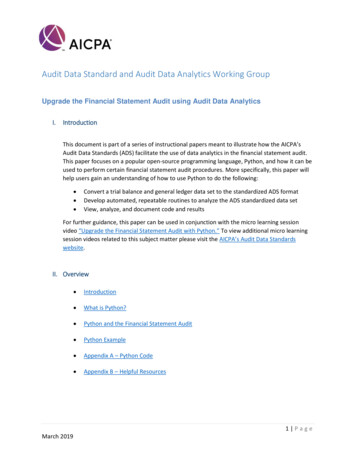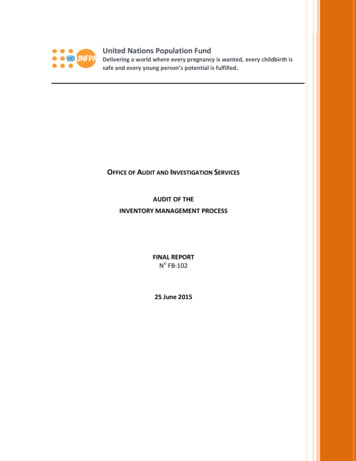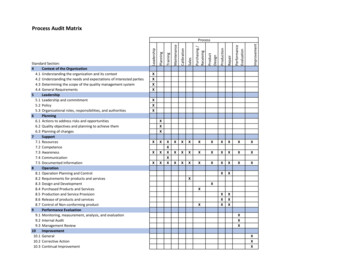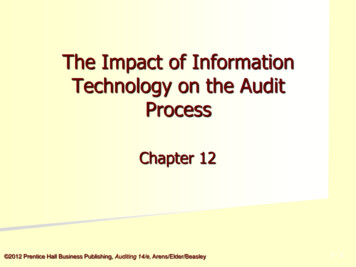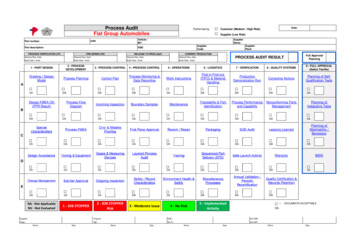
Transcription
Process AuditFiat Group AutomobilesPart description:Supplier (Low Risk)SupplierName:RELEASE TO PROD.(DaP)PRE-SERIES (PS)SupplierPlant:SupplierCode:SQE:PROCESS VERIFICATION (VP)Date:Customer (Medium / High Risk)Vehicle /MY:OdM:Part number:Performed byCURRENT PRODUCTIONMaterial Req. Date:Material Req. Date:Material Req. Date:Material Req. Date:Build Date / Avail.:Build Date / Avail.:Build Date / Avail.:Build Date / Avail.:Full ApprovalPlanningPROCESS AUDIT RESULT1 - PART DESIGN2 - PROCESSDEVELOPMENT3 - PROCESS CONTROL4 - PROCESS CONTROL5 - OPERATIONS6 - LOGISTICS7 - VERIFICATION8 - QUALITY SYSTEMS9 - FULL APPROVAL(Select Yes/No)Drawing / DesignModelProcess PlanningControl PlanProcess Monitoring &Data RecordingWork InstructionsFirst-in First-out(FIFO) & MaterialHandlingProductionDemonstration RunCorrective ActionsPlanning of SelfQualification TestsDADAADADADesign FMEA OK(PPR Result)DAProcess FlowDiagramDAIncoming InspectionBoundary SamplesMaintenanceDATraceability & PartIdentificationDAProcess Performanceand CapabilityDANonconforming PartsManagementPlanning ofIntegrative TestsBDASpecialCharacteristicsDADADAError & MistakeProofingProcess FMEADADAFirst Piece ApprovalRework / RepairDAPackagingDASQE AuditDALessons LearnedCDADesign AcceptanceDADATooling & EquipmentDAGages & MeasuringDevicesDADALayered ProcessAuditTrainingDASequenced PartDelivery (SPD)DASafe-Launch ActivityPlanning ofMatchability /BenestareDAWarrantyIMDSDDAChange ManagementDADADASub-tier ApprovalOutgoing InspectionDADASafety / ReportCharacteristicsEnvironment Health &SafetyDAMiscellaneousProcessesEDANA - Not ApplicableNV - Not EvaluatedDADADA1 - JOB STOPPER2 - JOB STOPPERRiskDADA3 - Moderate Issue4 - No RiskSupplierProgramSQE /Resp.:Mgr:SQ TL:NameSign.NameSign.DAAnnual Validation /PeriodicRecertificationDADAQuality Certification &Records RetentionDA5 - ImplementedActivity DOCUMENTS ACCEPTABLEDASQ CMS /SQ CMT:NameSign.NameSign.
#SectionRequirementsDocumentsThe drawing / design model shall have all required information for the part, including but not limited to:- engineering/technical standards, specifications, and Norms (plus any deviations from those requirements);- GD&T / dimensional requirements;- engineering Build Objectives or Table of Tolerances/Profiles considered;- identified special characteristics;- a list of sub-components (with part number, revision level, and quantity).Datum schemes shall be agreed upon by the Customer and consistent with part mating/attachment points.1ADrawing / DesignModelReference* Drawing / Design ModelThe Supplier shall have access to all Customer standards, through the applicable Customer system. They shall have aprocedure that requires regular reviews to ensure they have the most recent released version, and communication totheir various departments in the event of a revision update. If Supplier internal specifications or standards arereferenced (e.g., on the design model, on sub-component drawings, etc.), those standards must be clearly linked tothe applicable Customer standard or specification.* Engineering Standards SupplierDistribution (ESSD)* FIAT Norms1BThe Supplier shall have available the Minimum Quality Requirements (MQR) and Statement of Requirements (SOR)for the part, signed by all applicable Customer and Supplier representatives. All requirements listed in the MQR shallbe included in the design model, test plan, control plan, or other technical documentation, as applicable.* Minimum Quality Requirements(MQR)* Statement of Requirements(SOR)Input the result of the DFMEA from the Process Planning Review (PPR).* Design FMEA (DFMEA)Design FMEA OK (PPR The Supplier shall have a procedure for development of DFMEAs and records that ensure all DFMEAs are periodicallyResult)reviewed and evaluated for continuous improvement of failure modes. Failure modes identified as the highest risk* Potential Failure Mode & EffectsAnalysis manual (4th Edition)* FIAT Norm 00270 / 00271* ISO/TS-16949 7.3.3.2* FMEA Development Procedureshall be addressed first. The procedure shall also include:- determination of severity, occurrence, and detection values;- regular reviews and updates for lessons learned;- updates of the DFMEA upon receipt of a Customer engineering change notice.1C1D1ESpecialCharacteristicsDesign AcceptanceChange ManagementSpecial characteristics (SC) or Key Product Characteristics (KPC) for the part and process shall be identified. Theseinclude product or process characterisitics that can affect safety, fit, form, function, performance, regulationcompliance, or subsequent part processing. The following types of characteristics fall into this category:governmental, Key/diamond ( D ), Safety/Emissions ( S and E ), Report (symbol), Buy-Off Points or Qh points,Critical Inspection Points (stoplight symbol), torque requirements, homologation requirements ( H ), andcharacteristics identified as SPC points on the design model. All SCs or KPCs shall be approved by the Chrysler/FIATEngineer and shown on the design model, in applicable quality documents (D/PFMEAs, Control Plan, work/inpsectioninstructions, etc.), and included in the SQE Audit and Initial Process Study. NOTE: It is not mandatory that all partshave SCs or KPCs.* Drawing / Design ModelIf the part does not have SCs or KPCs identified on the design model, the Supplier and Process Audit team shall selectcharacteristics that affect close tolerances, fit, function, finish, reliability, durability or characteristics affected byprocess parameters and/or characteristics that affect the successive/final process to include in the SQE Audit andprocess performance and capability studies.* List of SCs/KPCs or selectedcharacteristicsThe drawings shall reflect some form of customer approval; i.e. Design Engineer’s signature, approved design changeorder, etc.Design responsible Suppliers are shall consider Design for Serviceability, which ensures ease of disassembly ofproduct with minimal cost and time.Approved Customer DrawingThe drawing or design model shall reflect the change/NIC level and revision level of the part(s) undergoing theProcess Audit. All applicable quality documents (including, but not limited to, the Process Flow Chart, D/PFMEA,Control Plan, and all Instructions) shall also reflect the correct change/NIC level and revision level.* Drawing / Design ModelThe Supplier shall have a procedure for proper change management, including:- receipt of customer approval (Change Notice or OdM);- updates of all applicable quality documents;- removal of uncontrolled or out-of-date documents;- quarantine/disposition/obsolesence of out-of-date material (product produced priot to the engineering change);- and communication of changes to all applicable sub-tier Suppliers. It is the Tier 1 Supplier's responsibility to ensurethe finished part is at the correct change/NIC and revision level. NOTE: The Supplier shall not make any changeswithout DOCUMENTED approval from the customer (i.e. voicemail, e-mail, etc. are UNACCEPTABLE).* Change Management procedure * ISO/TS-16949, cl. 4.2.3.* Authorized engineering changesdocumentsPagina 2 di 15
#SectionRequirementsDocumentsReferenceThe SQE shall verify that all open issues from the Process Planning Review are "Green" (4 or better). If any open issues * Process Planning Reviewremain open ("Red" or "Yellow"), give the equivalent score for this item.2AProcess PlanningThe Supplier shall support all Customer systems (e.g., MaPS, CQMS, SQP, NCT, eCIMS, etc.). They shall have at least 2fully trained individuals able to access each system. The Supplier shall keep contact information current and updated.A Process Flow Diagram is required for all parts and shall reflect the entire process, beginning at the Receiving area* Process Flow Diagramand continuing through Shipping. It shall include all labeling, product storage, rework/repair, and gaging/inspectionareas, whether they are a part of the primary process or off-line (secondary) processes. Stations which measurespecial characteristics and/or contribute to significant nonconformances shall be identified. Process and material flowshall be designed to avoid missing of operations or mixing of parts with similar products.2BProcess Flow DiagramThe Process Flow Diagram shall include the processing sequence, method, and equipment used at each station(including inspection and repair/rework stations). All unique machine numbers shall be identified. For rework/repairoperations, it shall indicate the flow of repaired or reworked material back into the normal process to ensure theparts pass through all required controls.The Process Flow Diagram shall identify the number of operators required per station (including float operators, asapplicable). It shall also indicate any bottleneck or constraint operations.A work station layout or manufacturing floor plan shall be available that details the following: operation to operationflow, all manufacturing / inspection equipment and tooling used in the process, identified material storage locations(for WIP / buffers, nonconforming material / scrap,rework / repair, and raw material / sub-components).* Process Flow Diagram* Process Flow Diagram* Work Station Layout /Manufacturing Floor PlanDuring the Process Audit, the SQE shall verify by witnessing on the manufacturing floor that the Process Flow Diagramand Work Station Layout reflect the actual process (i.e., number of operators, identified tooling and equipment, etc.)and that facilities, equipment, lighting, etc. are adequate.A Process Failure Mode & Effects Analysis (PFMEA) shall be available for all parts. It shall be created using all* Process FMEA* Potential Failure Mode & EffectsCustomer guidelines and required FMEA reference manuals. The PFMEA shall be reviewed by the SQE and rated* Supplier PFMEA Audit Summary Analysis manual (4th Edition) AIAG"Green" per the "Supplier PFMEA Audit Summary" form.* FIAT Norm 00271* ISO/TS-16949 7.3.3.2* Supplier PFMEA Audit Summaryform2C2DProcess FMEATooling & EquipmentThe Supplier shall have a procedure for development of PFMEAs and records that ensure all PFMEAs are periodicallyreviewed and evaluated for continuous improvement of failure modes.Failure modes identified as the highest riskshall be addressed first.Potential causes and effects of "Buzz / Squeak / Rattle" and "Noise / Vibration / Harshness" (BSR/NVH) shall beaddressed in the FMEAs, Control Plan, and Test Plan. Analyses shall include evaluations of interactions with matingparts to reduce, eliminate, and/or monitor objectionable BSR or NVH characteristics. It is the Supplier’s responsibilityto ensure their parts do not exhibit any BSR/NVH conditions within their environments.* PFMEA review / evaluationprocedure & recordsThe Supplier shall have a complete list of all dies/tooling, equipment, and gages used in the process. This list shallindicate ownership of the tooling, unique identification numbers, and location of the item. The SQE shall verify thepresence of all tooling (including number of cavities), equipment, and gages identified on the list. Tooling andequipment, when not in use, shall be properly identified and stored to avoid confusion in the flow management ofcomponents/products being manufactured.* Tooling list* Process FMEA* Control Plan* DVP&R / AQF & PIThe SQE shall verify die/tooling, equipment, and gage status in terms of: timing (completion, try-out, sampling, etc.), * Program Reviewfunction, and part availability for key program milestones. Tools and equipent shall be built following all requirements * MQRin the MQR, as applicable. The Process Audit and PDR shall be run on finished production tools using definitiveproduction processes.All Customer-owned tooling shall have a tooling kick-off from the appropriate customer representatives. Tooling* Tooling Kickoff (TKO)developed/followed by the customer Tooling Analysis Group (TAG) shall have a tooling sign-off from the applicableTAG representative.Customer-owned tooling, equipment, and gages shall be identified and marked per customer requirements. It shall beused only for the production of Chrysler/FIAT products. Tools shall meet the requirements in FGP procedure 24.The Supplier shall have a process for evaluating the risk of each purchased sub-component and raw material used inthe part. Those sub-components not considered low risk shall have a Process Audit (or equivalent) led by the Tier 1Supplier and followed with a Level 3 PPAP submission (or equivalent approval) to the Tier 1 Supplier. Samplessubmitted for PPAP shall be properly stored, preserved, and handled, as applicable.* CG Business Processes (Readinessof Design To Start Supplier Tooling Kick-Off)* FGP Procedure 24* Sub-component risk* Sub-component Process Audits* Sub-component Approvalsubmissions & samplesIf sub-component approval is granted via deviation, it shall be temporary and shall indicate the quantity and/or the* Sub-component Deviationsvalid time period. Deviation on sub-components must be approved by the Customer first, then approved by theapplicable Supplier department(s). NOTE: Violation of this requirement requires immediate placement of the Supplieron CSL or 3CPR Level 2. Process Audit approval will not be given if any sub-component is under a deviation and/or notapproved (except for Directed or Consigned components; see 3B Incoming Inspection).3B Incoming InspectionThe Supplier shall ensure all Customer quality requirements (e.g., MQR, quality planning, Process Audit, etc.) arecommunicated throughout the Supply Chain. The Supplier shall request approval from the Customer for all processchanges using the appropriate system (e.g., the Forever Requirements) prior to implementing the change. In addition,the Supplier shall ensure these requirements are communicated down throughout the Supply Chain. The Tier 1Supplier is ultimately responsible for all changes initiated by their Sub-tier Suppliers.2ESub-tier ApprovalThe Supplier shall have a list of approved sub-tier Suppliers for each sub
During the Process Audit, the SQE shall verify by witnessing on the manufacturing floor that the Process Flow Diagram and Work Station Layout reflect the actual process (i.e., number of operators, identified tooling and equipment, etc.) and that facilities, equipment, lighting, etc. are adequate. *

